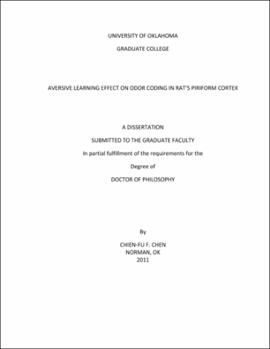| dc.contributor.advisor | Wilson, Donald A||Berkowitz, Ari | |
| dc.creator | CHEN, CHIEN-FU FRED | |
| dc.date.accessioned | 2019-05-01T17:25:54Z | |
| dc.date.available | 2019-05-01T17:25:54Z | |
| dc.date.issued | 2011 | |
| dc.identifier | 99152414102042 | |
| dc.identifier.uri | https://hdl.handle.net/11244/319521 | |
| dc.description.abstract | Olfaction, a sense for detecting and discriminating chemical molecules in the environment, is critical for animal survival, reproduction and other adaptive behaviors. The olfactory system is organized in three major stations (a sensor sheet, an initial processing and projection unit, and a central processing unit) that are shared across phyla, and has been functioning for millions of years. Since Buck and Axel identified a multigene family for coding the olfactory receptors, knowledge of the olfactory system has quickly accumulated in the last 20 years. This allows us to investigate fundamental questions in olfaction, including how odor percepts are formed, how olfactory information is used and stored, and how experiences shape olfactory perception in our daily life. | |
| dc.description.abstract | Aversive events involving olfactory information are commonly experienced in nature. In the lab, aversive olfactory experiences have been shown to modify odor responses in rodents behaviorally and physiologically. Traditionally, studies regarding olfactory aversive learning were conducted by using odor-shock conditioning. Here, I explored the possibility of using 2-way active avoidance conditioning for awake unit recording in rats. The results confirmed previous findings that the rats can learn to actively avoid both auditory and olfactory cues that are associated with a dangerous event. Interestingly, the rats appeared to have rapid acquisition but poor behavioral retention. After comparing between the two paradigms, I decided to use odor-shock conditioning for chronic unit recording in awake rats. | |
| dc.description.abstract | Three different odor-shock conditioning paradigms were used to investigate how aversive learning affects odor processing in the olfactory cortex. We first found that odor-evoked fear responses were training paradigm-dependent and each induced different levels of fear responses and odor generalization. In addition, we observed a decrease in spontaneous firing rate in the olfactory cortical neurons after conditioning and that was associative learning dependent. The results also suggested that generalized fear is associated with an impairment of olfactory cortical discrimination. In conclusion, changes in sensory processing are dependent on the nature of training, and can predict the behavioral outcome of the training. | |
| dc.format.extent | 120 pages | |
| dc.format.medium | application.pdf | |
| dc.language | en_US | |
| dc.relation.requires | Adobe Acrobat Reader | |
| dc.subject | Smell | |
| dc.subject | Odors | |
| dc.subject | Sensory neurons | |
| dc.subject | Rhinencephalon | |
| dc.subject | Rats--Anatomy | |
| dc.title | Aversive learning effect on odor coding in rat's piriform cortex | |
| dc.type | text | |
| dc.type | document | |
| dc.thesis.degree | Ph.D. | |
| ou.group | College of Arts and Sciences::Department of Biology | |
